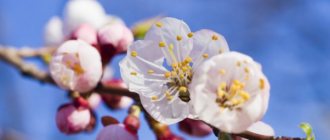The variety of varieties is amazing. Photo by the author
We must honestly admit that it is quite difficult to navigate the sea of peonies (both among old varieties and among new ones). This is not easy to do, even by studying catalogs. Visiting exhibitions also does not give the full picture. Usually only the peony flower is presented there, and everything else remains behind the scenes: the timing and abundance of flowering, the habit of the bush, its comparative characteristics - height, strength of the stems, color and “shape” of the leaves (they can be large, shiny, narrowly dissected, etc.). P.).
At the exhibition in Chelsea (London). Photo by the author Meanwhile, such information is far from superfluous. We need to know what time the bush blooms, its height, whether it is spreading or compact, what color and shape the flowers are. You will not get such information from grandmothers selling at the market: they will offer you a “red”, “white” or “pink” peony without other identifying features. Advanced grandmothers will show you a photo of a flowering plant - that’s already good! Where is the guarantee that the image corresponds to what you will eventually grow? After all, the deception will be revealed no earlier than in 3-4 years.
What conclusion can be drawn from all of the above? It is necessary to approach the choice of varieties extremely responsibly, because peony is planted for a long time. If it does not live up to your expectations, it will still be a shame to throw it away later. So for many years he will remind you of your illegibility and haste. Conclusion two: it is better to choose varieties from among those that are already known and have proven themselves. And the third conclusion: before you decide to buy (and peonies are now in price), you should consult knowledgeable people - collectors at exhibitions.
The choice is difficult to make. Photo by the author I want to compile for you a kind of “cheat sheet” with the names of already proven and popular varieties. At one time, when I began to form a collection, it took a lot of effort to choose certain varieties. Now, after many years, I cannot say that it was infallible: it would have been possible to have a greater variety of shapes and colors. But all the plants planted in my garden are beautiful, each peony in its own way.
Peonies in the garden. Photo by the author
Ads by
Historical varieties
The most famous, perhaps, are the legendary vintage ' Sarah ' (1906) and ' Festiva ' (1851).
These varieties are many years old, but they are still beautiful and in demand. You can read more about them in the publication Peonies that can surprise: the most memorable varieties and types. The incomparable 'Sarah Bernhardt' is an extraordinary blackcurrant ice cream color. Photo by the author These are profusely and long-blooming peonies, resistant to disease (otherwise they would not live so many years!), and good for cutting. Using the terminology of international competitions, they undoubtedly deserve the Grand Prix.
'Festiva Maxima' is a well-recognized and beloved peony. The flower has characteristic crimson strokes. Photo by the author
If you want to expand the color palette of peonies in your garden, among the ancient ones, the French dark burgundy variety of medium flowering period ' Marechal Mac Mahon' ('Marshal Mac Mahon') and ' Felix Crousse' ('Felix Cruss') deserve attention, abundantly and long-lasting blooming with large violet-red flowers with silvery tips of the petals. 'Felix Crousse' blooms profusely, all the flowers bloom together and do not fall off for a long time. Photo by the author Magnificent fragrant varieties:
- 'Madame de Verneville' ('Madame de Verneville') - white-pink, has a rose scent;
- 'Duchesse de Nemours' ('Duchesse de Nemours') - early blooming, with the scent of lily of the valley, white flower with yellow highlight.
Their flowering reminds of childhood and grandmother's garden, where they spent the summer.
These varieties are still alive and quite often found on sale. On the left is the peony 'Madame de Verneville', on the right is 'Duchesse de Nemours'. Photo by the author We can recommend a few more beautiful French peonies.
- ' Albert Crousse' ('Albert Crousse', 1893) - pink-shaped, warm pink tone, decorates the garden already at the end of flowering of the majority of varieties;
- ' Monsieur Jules Elie' ('Monsieur Jules Elie', 1888) - pink-lilac. He and 'Albert Crusse' were repeatedly recognized as show leaders at exhibitions;
- 'Reine Hortense' ('Reine Hortense', 1857) is an old French peony, double, rose-shaped, soft pink in color with a rich center. In 2022, it won the People's Choice Award.
Peony 'Monsieur Jules Elie' has a pink-lilac color. Among the oldest varieties at exhibitions you can see incomparable peonies, which, as it turns out, are not afraid of age. In particular, the Lemoine variety 'Edulis Superba' ('Edulis Superba', 1824).
Terry, crown-shaped, pink-lilac, unusually fragrant, like all “French”. It is often found in gardens and markets, but we do not even suspect what a treasure it is, considering it just an ordinary peony, which we are used to. In our market, which unites large online stores, you can choose the varieties of peonies discussed above. Take a look at the selection of Amazing peonies of French selection.
Herbaceous peony for patio MADRID, 1 pc. 603 RUR
seedspost.ru
Herbaceous peony Duchess de Nemours 519 RUR
Agrofirm Search
Peony milky-flowering Sarah Bernhardt (V3l.) 738 RUR
Agrofirm Search
Herbaceous peony Felix Krauss 429 RUR
Agrofirm Search
Description of the plant
Peonies (Paeonia) are perennial herbaceous, shrub and subshrub plants of the Peony family (Paeoniaceae). There are 36 species growing in nature, from which more than five thousand varieties have been bred.
The distribution area includes the temperate and subtropical zones of North America and Eurasia.
Peonies are equipped with a powerful root system in the form of large cones. Several massive stems become woody with age, turning into trunks and do not branch much.
The shape of the leaves is pinnate, divided into lobes. The color of the leaves is dark green, gradually changing depending on the time of year to dark lilac.
Peonies bloom in large flowers, with numerous petals and are represented in the entire color palette.
After flowering, a fruit is formed in the form of a composite, star-shaped multi-leaflet, which contains seeds.
Peonies have been used in cooking and medicine for several thousand years. Their petals are used to make salads, drinks and candied fruits. Tinctures from peony petals have sedative properties and are used as an anti-allergenic and sedative.
American varieties that have become classics
American breeders have given us a huge number of varieties and hybrids, but only enthusiastic collectors and cultural connoisseurs are familiar with them. Getting the right variety now is not a problem. What can you recommend to flower growers starting to create a collection? European nurseries supply a huge assortment of peonies, among which American “aliens” are in first place. In particular, at the last exhibition (2019) at the Flower Growers Club in Moscow, the winner of the show was the late-flowering variety 'Marilla Beauty' ('Marilla Beauty', 1940) with huge (diameter 20 cm) double flesh-colored flowers.
'Marilla Beauty' is a late-flowering variety, winner of the show at the peony exhibition in 2022. Photo from gardengallereya.ru
White peonies
White varieties of American origin include:
- 'Gladys Hodson' ('Gladys Hodson', 1961) – white-cream, slightly pinkish when blooming, blooming extremely profusely with large double pink flowers; powerful bush up to 1 m high;
- 'Elsa Sass' ('Elsa Sass', 1930) - a superbly composed creamy flower with richness in the central funnel;
- 'Corinne Wersan' ('Corina Versan', 1955) - terry, pinkish, creamy outside, with a pinkish center and a rose aroma.
On the left is the peony 'Corinne Wersan', on the right - 'Florence Nicholls'. Photo from americanpeonysociety.org
- 'Doris Cooper' ('Doris Cooper', 1946) – double, pink-shaped flower of dense build; large textured petals are creamy pink, then lighten. Grand champion of the American Peony Society (APS) exhibition in 1958 and 1967, winner of the APS gold medal in 1949 - and that means something!
- 'Florence Nicholls' ('Florence Nicholls', 1938) deserves special attention. The outer petals are light pink with a creamy yellow base and a cream center.
At first glance, all these terry white peonies are similar to each other: sometimes you can’t tell which variety is in front of you.
They often bloom soft pink, then lighten and turn white, many with a creamy highlight in the center. At the same time, what distinguishes them from each other is, firstly, their height (from 60 to 100 cm); secondly, foliage (dark, light, olive, shiny or matte, large or small, dissected, etc.); and thirdly, the timing of flowering. Interesting varieties can often be found among enthusiastic collectors. Take a look at Irina Pavlovna Sokolova's collection - we found 'Corinne Wersan' and 'Dresden Pink' there.
Planting and care: breaking traditions
Peonies cannot be called capricious plants, however, they make high demands on lighting and soil. If you want to grow a beautiful, healthy bush that will delight you with luxurious blooms for many years (and peonies are famous long-livers!), you will have to work hard.
The ideal soil is well-cultivated loam with a slightly alkaline reaction. Lime must be added to acidic soil. The secret of Dutch flower growers for planting and caring for peonies in the open ground: aquatic vegetation removed when cleaning ponds is laid out in flower beds (duckweed with a high lime content is an especially good fertilizer).
Planting holes should be deep and wide (50-70 cm), which is more important on heavy soils. On clay soil that does not permeate moisture well, the holes should be made even deeper so that drainage can be arranged using broken bricks or gravel.
Butterflies: beautiful creatures from the world of insectsHow to grow excellent petunia seedlings
- How to properly water an orchid in a pot: the benefits of automatic watering for the plant
Although peonies are very demanding when it comes to soil moisture, they absolutely cannot stand constant dampness and stagnation of water - their roots will simply rot. The pits are filled with a nutritious earthen mixture (humus and peat with the addition of bone meal or superphosphate).
All excavation work must be carried out in advance, 2-4 weeks before the expected day of planting peonies, so that the soil has time to settle. A vitally important point when planting a division is the depth: strictly from 3 to 5 cm from ground level.
Lower or higher, and the peonies will not bloom, this will affect both the health of the plant and its life expectancy. Some gardeners measure the required distance with a ruler - and, I must say, it’s worth it.
The best time for planting and replanting peonies in the middle zone is considered to be the period from mid-August to mid-September. At this time, the plant is at rest and will tolerate stress more easily. Only in the fall: your own peonies, bought “from grandmothers” at the market, or donated by neighbors.
But since the arrival of peonies from Holland, Poland, and China on the domestic market, the situation has changed radically: now everyone has to plant newly purchased peonies, contrary to laws, traditions and rules - in the spring. This is bad, but nevertheless quite acceptable.
The purchased root must be kept in the refrigerator until planting to prevent bud growth. It is important not to overdry or overwater the root, trying to maintain the most optimal humidity. Plant in the garden before it gets warm or hot.
Mulch the plantings. Remember to water and weed regularly: such a plant develops very slowly, and it is too weak in the first couple of years to withstand weeds or drought on its own.
In short, a small peony planted in the spring will need care and attention. But in the end, a luxurious bush will grow from a tiny piece of root, and it will bloom - and this is the best reward for all your work!
A small bonus: peonies do not need to be covered for the winter, which sets them apart from some other perennial flowers. Only young plants and all new plantings need minor shelter. In one place, a peony bush can grow and bloom beautifully for about 20 years.
Pink varieties
Pink varieties of peonies are much more variable, which complicates our choice. This color can be different: from the most delicate tone of a girlish blush to rich crimson, cyclamen, fuchsia colors. The variety of pink peonies is amazing. 'Susie Q' ('Susie Q', 1970)
is very attractive Peony variety 'Susie Q'. Photo by the author Soft pink ' Pink Formal' ('Pink Formal', 1953) surprises with its aroma, flower size (up to 20 cm in diameter), and also because it does not fade and retains color until the end of flowering.
Luxurious 'Pink Formal' flowers. Photo by the author Magnificent super-double pink 'Dresden Pink' ('Dresden Pink', 1957) with tightly packed flowers. There is a characteristic funnel in the center, the edges of the petals are slightly wavy with silvery tips. A luxurious variety, it is best to consider it as a cut flower, as the stems bend low and cannot support heavy flower heads. Requires support.
Cut variety 'Dresden Pink'. Photo by the author The exceptionally profusely blooming pale pink peony 'Florence Ellis' ('Florence Ellis', 1948) captivates with its airiness.
Peony 'Florence Ellis'. Photo by the author
Among the dark pinks, ' Felix Supreme' ('Felix Supreme', 1955) stands out - a double, pink-shaped, ruby-red flower. 'Felix Supreme' in the garden in full sun. Photo by the author In the publication Peonies that can surprise: the most memorable varieties and species, the wonderful variety 'Princess Margaret' ('Princess Margaret', 1960) was already noted. It produces an exceptionally abundant bush that blooms for a long time due to the lateral buds. The flowers are fuchsia pink with silver tips on the petals.
Peony 'Princess Margaret'. Photo by the author
Red peonies
' June Brilliant' ('June Brilliant', 1938)
was rightfully recognized as the leader among red varieties at the last exhibition at the Moscow Flower Growers Club This peony has “curly” flowers with large petals, the edges of which are carelessly cut out with scissors, and an unusual deep color of dark potassium permanganate. On the left is the peony 'June Brilliant'. Photo from the site gardengallereya.ru. On the right is 'Red Grace'. Photo from americanpeonysociety.org Among the red peonies, there are three truly magnificent hybrids: 'Red Grace' ('Red Grace', 1980), 'Red Charm' ('Red Charm', 1944) and the king of the audience's choice ' Henry Bockstoce' ('Henry Bockstoce', 1955).
On the left is the peony variety 'Red Charm', on the right is 'Henry Bockstoce'. Photo by the author In these peonies, breeders managed to achieve a unique deep red color without any admixture of blue and purple.
Bouquets and compositions of peonies
Peony is one of the best flowers to cut, if not the best. There are even special cut varieties. On the site they are planted separately, away from the front area of the garden. The standard stem length is 40 cm. This is a lot if you cut off all the flowering shoots from the bush.
In order to accumulate enough strength for flowering next year, the bush must have at least half of the shoots left - they cannot be cut off.
The highly decorative nature of the flower allows you to create bouquets of peonies that are monochromatic, contrasting or shading each other.
If in our country varieties with large, double flowers are always popular and universally loved, then Japanese florists literally idolize simple, non-double peonies. They are considered the kings of the ancient art of ikebana. After all, the talent of a florist lies in emphasizing the individual beauty and uniqueness of each flower.
The soil
This plant grows in almost all types of soil, but it will develop differently.
- Leaves develop better on sandy soil than flowers.
- On clay soil you can get larger flowers, but growth will be slower.
The best option is loamy soils, drained, moisture-absorbing and with an acidity of 5.8 to 7.0.
Peonies are frost-resistant plant species.
Good predecessors - the best option would be green manure and black fallow or virgin soil.
Bad predecessors are shrubs, trees and large perennials, which significantly deplete the fertile layer of soil.
How to grow
If peonies are planted in August or early autumn, they are planted directly into the ground. To do this, prepare the planting site by digging and adding mineral fertilizers, adding lime to reduce acidity. Nitrogen, phosphorus and bone meal are best suited.
- Holes 50 cm wide, long and deep are prepared for the bushes. Fertilizers are added to the bottom - humus, superphosphate, ash, phosphorus flour and everything is thoroughly mixed with the soil.
- Water it well with manganese solution, make a small mound, install the bush so that the upper buds go no more than 5 cm into the ground and straighten the roots.
- Cover with soil, water and mulch.
Care consists of regular watering and mandatory loosening of the soil. Weeds should not be allowed to actively grow; they should be removed. When the bushes grow, they are given supports to support large buds. During the growth process, fertilizing is carried out; three are enough - in the spring and two in the summer.
The seedling method is used for planting seeds in winter in order to plant ready-made seedlings in the spring. At the initial stage, the seeds are sown in small containers with sand and placed on a heating pad. During the daytime, the temperature is maintained at about +30ºС, and at night +15ºС. Periodically, the sand is watered with a spray bottle.
After the roots appear, the seedlings are transplanted into a container with fertile soil or peat mixture. The temperature is maintained from +5ºС to +10ºС, and after the leaves appear about +19ºС. It is necessary to ensure regular watering. You can start diving after the first two leaves appear.
Watering the seedlings is done with a solution of mineral fertilizers. After diving, fertilizing is carried out a week later.
Flowering time
White peonies have different flowering periods. Thanks to this, several varieties can be grown on the site. This means that when some buds fade, new ones will bloom. As a result, you can enjoy the sight of these beautiful plants all summer long.
There is a classification based on the time of bud blooming, which usually occurs in the first month of summer:
- spring, bloom until June 5;
- early, bloom from 5 to 10;
- mid-early, blooming from June 10 to June 15;
- average: from 15 to 20;
- medium-late, the buds of which bloom by June 20–25;
- late ones, begin to bloom from 25 to 30;
- very late, bloom after June 30.
Thus, with the right choice of varieties, you can achieve flowering throughout the summer.
Important. The buds bloom in 2 – 3 weeks. Therefore, it is necessary to select varieties based on the duration of flowering.
Henry Boxtos
Peony Henry Boxtos is a stunningly beautiful interspecific hybrid that has won a huge number of awards. Its huge inflorescences of a luxurious ruby hue can claim to be the main decoration of the garden.
The magnificent pink-shaped flowers of this peony look spectacular in bouquets and floral arrangements.
The plant can withstand winters when temperatures drop below –30°C. Peony loves good lighting, but can also feel comfortable in partial shade.
| Petal color | Flower diameter (cm) | Bush height (cm) | Flowering time |
| Ruby red | 20-22 | 90-120 | End of May – June |
Bowl of Cream
Bowl of Cream is a spectacular milky flowering peony. Its name means “bowl of cream,” and the coloring of the petals of the cup-shaped flower confirms this similarity. The inflorescences of this peony are whitish-cream, reminiscent of whipped cream in color.
Bowl of Cream is winter-hardy, easy to care for, and usually does not require garter.
| Petal color | Flower diameter (cm) | Bush height (cm) | Flowering time |
| Cream | Up to 30 | 80-90 | End of May – June |
Root collar
The most important place where root tubers turn into stems is called the root collar. It is here that the renewal buds are located, and it is in this place where the dying stems are located that the infection can lurk. Carefully inspect the root collar before planting, carefully strip it with a knife to healthy tissue, periodically disinfecting the tool. If you suspect the presence of a disease, treat the cuttings in a solution of potassium permanganate or the drug Maxim Dachnik, which prevent the development of fungal diseases.
When dividing a peony bush in your garden, having received planting material from the store or from fellow gardeners, arm yourself with pruning shears or a garden knife, means for treating wounds, disinfecting tools and fungicides. Be careful and maintain a reasonable balance to get your ideal peony cut.
Red Charm
Red Charm (or “red charm”) is a catchy, beautiful, attention-grabbing variety of terry peonies. The diameter of the red bomb-shaped inflorescences exceeds 20 cm, so sometimes the bush needs a garter.
A pleasant feature of this plant is its shiny dark green leaves, which remain decorative until frost.
The rich aroma of Red Charm peonies attracts a large number of butterflies and bees.
| Petal color | Flower diameter (cm) | Bush height (cm) | Flowering time |
| Dark red | 20 | 70-90 | End of May – June |
Red Spider
Red Spider is an attractive low-growing peony hybrid from the Rock Garden group (rocky garden). It loves sandy, rocky, limestone soils, good sunlight and can withstand low temperatures.
This “red spider” is notable for its charming bright crimson inflorescences. Red Spider “lives” in bouquets for a long time, so it is ideal for cutting.
| Petal color | Flower diameter (cm) | Bush height (cm) | Flowering time |
| Bright crimson | 18 | 30-60 | End of May – beginning of June |
Festiva Maxima
The herbaceous peony of the Festiva Maxima variety has been decorating European gardens since the century before last. The color of the petals is interesting: they are snow-white, in places with an elegant dark crimson edging.
Peonies from the Festival Maxima have a strong, pleasant aroma and stand well in bouquets. The bushes retain their beautiful appearance after flowering ends.
| Petal color | Flower diameter (cm) | Bush height (cm) | Flowering time |
| White with crimson trim | 15 | 80-90 | End of May – June |











